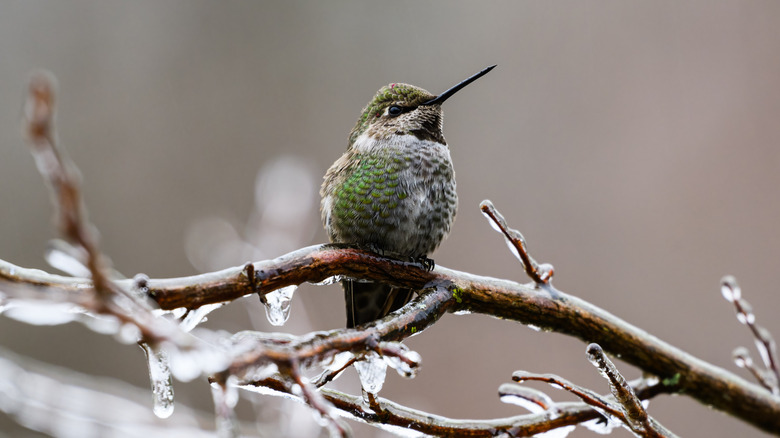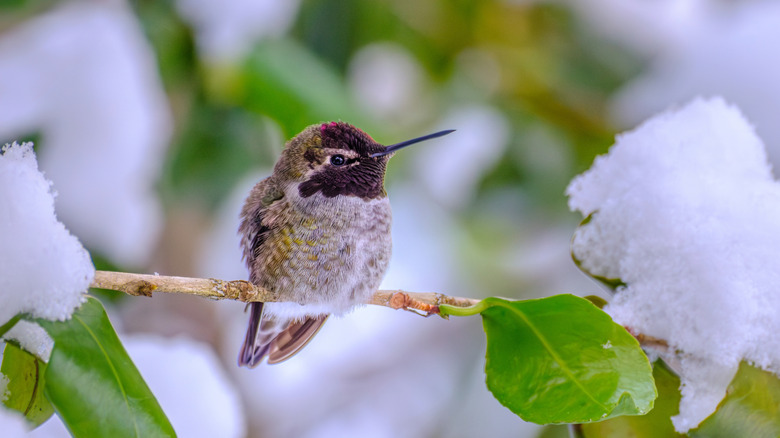The Unexpected Reality Of How Hummingbirds Survive Winter
We may receive a commission on purchases made from links.
Over 300 million birds across 458 species migrate to warmer climates to escape winter weather. While these figures may seem staggering, there are 831 species in North America, showing that many birds stay in their native habitats year-round. The hummingbird, however, does both, with some embarking on that miraculous journey and others staying put.
Most of the 16 hummingbird species in North America migrate. The longest flier, the ruby-throated hummingbird, can travel over 500 miles, namely over the Mississippi River, across Texas, and past the Gulf Coast. To prepare for this journey, hummingbirds gain 25% to 40% of their regular body weight with two methods. An increase in diet is essential, but the hummingbird also slows its metabolism using a technique called torpor. Torpor is a hibernation-like state that animals use to lower their body temperature and reduce their metabolic rate.
Other species make shorter trips, as they already reside in warmer climates with less-pronounced weather fluctuations. However, the Anna's hummingbird is an exception to the rule, as it's found as far north as Canada and Alaska and lives in cold locations year-round. An Anna's hummingbird fluctuates its daily weight to survive the harsh winter, putting on up to 16% throughout the day just to lose it at night as it keeps the bird warm and alive. Instead of making a long trip, the Anna's hummingbird has learned to adapt to temperatures that can easily drop to freezing while relying on insects and nectar feeders. Thankfully, there are ways that bird enthusiasts can help hummingbirds during the winter months, too.
How to help a hummingbird survive the winter
As a highly sought-after garden visitor, many desire to keep a hummingbird as a pet, even though it's a costly mistake. Allowing them to fly free is essential, particularly for those who make the long trip. A hummingbird in torpor may appear injured, but watching it, which could take up to half an hour, should confirm whether it's hurt or conserving energy for flight. Disturbing this state can cause unnecessary stress, but calling a veterinarian who works with birds while keeping an eye on the hummingbird can help you understand what it's experiencing.
Anna's hummingbirds have become dependent on seasonal nectar feeders that provide them with essential energy in the form of sugar water. Thankfully, the sugar water recipe for hummingbirds is straightforward and affordable. However, hummingbird feeders require extra maintenance beyond regular cleaning to avoid the buildup of harmful mold in the winter, and to prevent freezing, a nectar feeder must be brought inside overnight. Alternatively, items like the Mr. Hummingbird Feeder Heater Warmer attach to most feeders seamlessly to keep your visitors and the nectar warm enough. Placing it in an area less likely to be disturbed by harsh winds and adding red accents will make a feeder more noticeable to the Anna's hummingbird.
Awareness of how hummingbirds migrate and a willingness to help those that don't are the best ways to aid the magnificent bird during and leading up to winter. Still, the little bird's perseverance, whether the far-flying ruby-throated or the winter-ready Anna's, is a testament to how adaptive the hummingbird is. Want more info on our feathered friends? Check out the best bird mothers in the animal kingdom that will have you 'aww'ing all day.
If you encounter an injured or sick wild animal, contact a local wildlife rehabilitator for help. To find assistance in your area, visit the Humane Society of the United States website or Animal Help Now's online directory.

